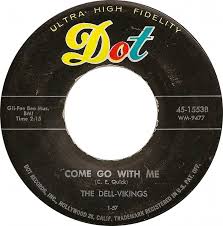[I happily interrupt this Hot Stove post to celebrate two big stories from Kansas City baseball. Yesterday morning, the Negro Leagues Baseball Museum received a check for one million dollars from the Major League Players Association and Major League Baseball. Go NLBM! In the afternoon, Salvy Perez hit a grand slam to knock out Boston and lead the Royals to their fourth straight series win. Go Royals!]
Rita and I have returned from our California stadium tour that took us through San Diego, LA/Anaheim and San Francisco/Oakland. We did a similar bus tour on the East Coast last year from Washington to Boston (reported in Hot Stove #22). We again used the excellent services of Darren Zinser of Triple Crown Travel (that’s him in the photo below as we get ready to board the bus).

There are only six major league stadiums over 30 years old. We saw three of them on this trip: Dodgers (1962), Angels (1966) and A’s (1968). The other three are Fenway (1912), Wrigley (1914) and Kauffman (1973). Populous, the sports architecture firm based in Kansas City, did not design any of these six stadiums – Populous (formerly HOK Sport) did not exist until 1983.
As for the remaining 24 stadiums, 19 have been designed by Populous (including Petco and AT&T that were part of our tour plus many of the other “retro” stadiums starting with Camden Yards). Populous also participated in renovations of the Angels and Royals stadiums.
Petco Park: Our first game was on Saturday, June 10, in San Diego. We did not attend the Friday night game, but took in a few innings from the rooftop bar of the Marriott (photo below). The Royals (and hundreds of KC fans) were in for the weekend series. The Royals lost the Friday night game, but did not lose again until the following Saturday. Six in a row, 7 of 9 on their road trip.
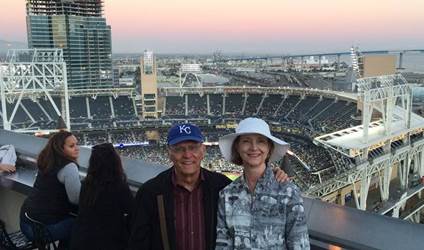
Petco Park opened in 2004 and is elegantly shoehorned into the Gaslamp Quarter of downtown San Diego. A unique amenity is the “Park at the Park” where fans can watch the game from a hillside beyond the center field fence. A large Tony Gwynn statue is located there, and the area is open to the public as a downtown park on non-game days. The designers incorporated a historic warehouse building in left field, and a corner of the building is the foul pole (squint and you will see the yellow stripe in the photo). The first floor of the building houses a nice Padres Hall of Fame, and the upper floors have been converted to fan suites. [Cosmic Question: If a ball hits the foul pole, it is fair. Should it be called a fair pole?]

The other thing to note in this photo is the scoreboard. The Royals scored nine runs in the 8th inning, capped by a grand slam by Lorenzo Cain. The teams combined for eight home runs, five by the Royals. It was the Royals first win in what would become a six-game streak.
Dodger Stadium: We left San Diego on Sunday morning and traveled directly to 1000 Vin Scully Avenue to attend an afternoon game between the Dodgers and the Reds. When the Dodgers moved to LA in 1958, they first played in the Memorial Coliseum (capacity 90,000) before moving in 1962 to Dodgers Stadium (capacity 56,000, largest in the majors). The stadium sits in Chavez Ravine and has aged well. There was one new addition this year: the first statue at the stadium, Jackie Robinson stealing home.
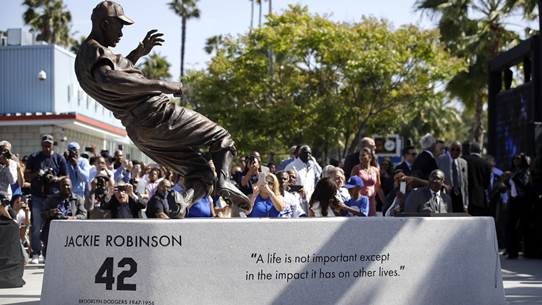
One part of the Dodgers stadium experience reminds me of the Royals: the sound system is turned up to 11. The screaming announcer with constant promotions and games. The loud music and videos telling fans when to cheer (because they apparently would not otherwise know). Former KC Star sportswriter Andy McCullough now covers the Dodgers for the LA Times, and I think his short tweet is a good summary of the phenomena: “I am a grumpy young man, but I could do with less cacophony at the ballpark.” Ditto, except I’m a grumpy old man.
We again saw eight home runs, four for each team. The Dodgers rode to a 9-7 victory on a grand slam in the 8th by Corey Seager. But it was the rookie Cody Bellinger that made us take notice. He had two home runs, his 15th and 16th, and he has continued to be hot – as of today, he is leading the NL with 22 homers. This gave us a nice lead-in to our next game which would feature Yankee rookie Aaron Judge, the AL leader in home runs (now at 24).
The back-to-back games in San Diego and LA were a reminder of the large/small market divide in baseball. The 25-man roster of the Padres will earn less this year than Dodger pitcher Clayton Kershaw:
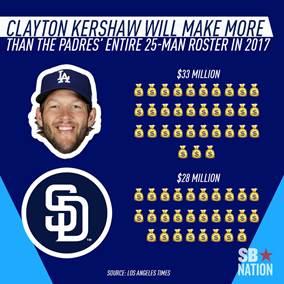
Angel Stadium of Anaheim: The Angels opened this stadium in 1966 (capacity 43,000). The LA Rams became co-tenants in 1980, and the stadium was expanded by 25,000 seats. As with most multi-purpose stadiums, the combined venue was not as comfortable for baseball. The Rams left in 1994, and controlling owner Disney joined with Populous to redesign the stadium and reduce the capacity to 45,000. Below, Rita stands in front of the jumbo size caps at the entrance. The stadium shows some age, but we thought it was a pleasant place to watch a game.
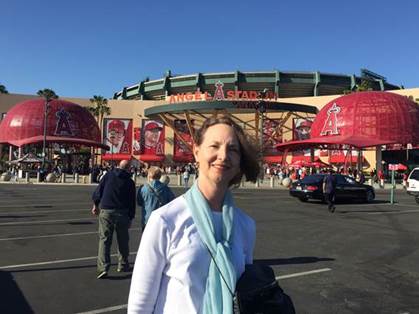
The stadium renovation included the “American Spectacular”, an artificial rock formation in left center field with flowing water and geysers, supplemented by fireworks for Angels home runs and victories. We got to see this in action in the very first inning when Kole Calhoun homered. Ever-alert Rita got this photo:

As for the Yankees/Angels game, most eyes were on 6’7”/282-pound Aaron Judge. He is the current favorite for AL Rookie of the Year and also getting MVP talk with the Angels Mike Trout injured. They each have a dedicated fan section in their home stadium. The Angels have a “Trout Farm” area in the outfield bleachers, while Yankee Stadium now has the “Judge’s Chambers” with faux wood paneling to resemble a jury box in the right field stands. The photo below shows Judge in right field the night we were there, and I direct your attention to the “601” at the top of the photo. That is the tracking number for career home runs by the Angels Albert Pujols (he is now at 602). Judge has some impressive Yankee predecessors in right field: Babe Ruth, Roger Maris, Reggie Jackson, Dave Winfield, etc. Yankee fans are ready to add Judge to that list.
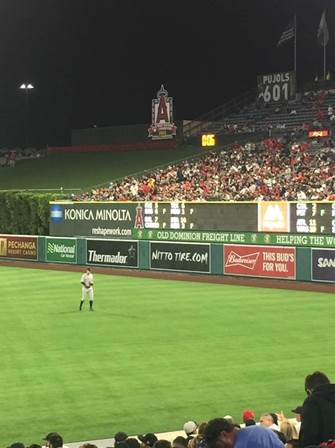
Judge did not disappoint at our game. In the 8th inning, he launched a two-run homer that was the margin of difference in the Yankees 5-3 victory. The homer we saw was long (438’), but nothing like the one he hit the day before at Yankee Stadium (496’, the longest in the majors so far this year). He was greeted by the large vocal contingent of visiting Yankee fans with chants of “MVP! MVP!” Some of those fans now sport robes and wigs like English judges.
The next morning, our group loaded up to head to San Francisco. There was an overnight stop in Cambria after a visit to Hearst Castle.
AT&T Park: Setting aside Fenway and Wrigley in a separate category, this is our favorite park of those we have seen. The stadium has been sold out since it opened in 2010. To beat the MLB record for sellouts (Red Sox – 794), the fans need to keep filling the stadium until sometime in 2020. Even if there are comparable stadiums, they don’t have this view:
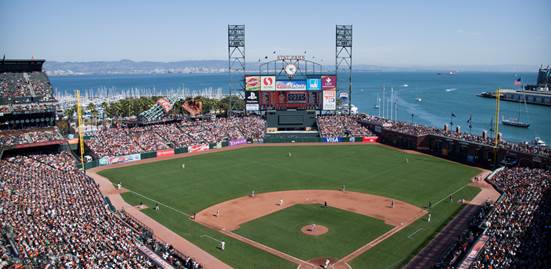
We reconnected with the Royals, and Mike Moustakas gave us a thrill in the 2nd inning when he hit a home run over the right field fence and into the bay (a/k/a McCovey’s Cove). On the video screen, we watched as a fisherman reeled in the ball with a special net at the end of his line. The ball bounced before going into the bay and so is not considered an official “splash” (must go in the bay on the fly). The Giants have a digital tracking screen in right field that currently counts 73 splashes, but this only includes those hit by Giants players (Barry Bonds has 35). Bonifacio and Cain also homered in the game as the Royals beat Johnny Cueto 7-2. As had been the case in San Diego, there was a lot of Royal blue in the stands, and those fans went home happy.
The next morning, we toured the stadium from the field to the upper deck, including the visitors’ locker room and dugout, the Tony Bennett suite, views of the various statues, etc. In the memorabilia collection, there is a display case and a large wall poster of the Giants winning the 2014 World Series – this stung a bit for the Royals fans. Although the Royals had left town, the visitors’ locker room still had reminders that they had just been there – a welcome sign and some names and numbers of the players on the lockers.
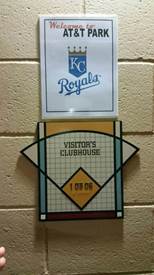
Oakland-Alameda County Coliseum: This stadium was completed in 1966 and was initially used only by the NFL’s Raiders. It was built as a multi-purpose stadium and so was ready for the A’s in 1968 when Charlie Finley moved the team from Kansas City. There are several grim reminders for Kansas City fans entering the stadium. A series of banners proclaims highlights from A’s history, many of which were performed by players originally in the Kansas City A’s organization. One banner features Catfish Hunter in honor of his perfect game – pitched the year after leaving KC. Just four years after leaving KC, the A’s ran off three straight World Series wins with the likes of former KC players Bert Campaneris, Reggie Jackson, Sal Bando, Joe Rudi, Dave Duncan, Dick Green, Blue Moon Odom, Vida Blue, Catfish Hunter and Rollie Fingers.
En route from LA to the Bay Area, Darren showed “Moneyball” on the bus TV system. The film tells the story of how Oakland General Manager Billy Beane successfully used sabermetrics to keep his small market team competitive. Since 2000, Oakland has made it to the post-season eight times, the last being the wild card game in 2014 against the Royals. Every team has followed Beane’s lead and computer geeks now operate throughout baseball.
The rules of sabermetrics do not help with the stadium. First, it is shared with the Raiders and suffers from the design necessary for two sports. The stadium shows its age. As for operations, the promotions during the game were generally lame, but there was one fun exception – John Belushi. Details below.
The A’s jumped to a 3-run lead, but the Yankees tied it up in the top of the 6th. The teams then traded single runs through the top of the 9th with this progression: 4-3, 4-4, 5-4, 5-5, 6-5, 6-6. The A’s did not score in the 9th, pushing the game into extra innings. The Yankees scored in the top of the 10th to take a 7-6 lead. Would the A’s mount a comeback? Ask John Belushi…
The video screen ran clips from “Animal House” showing John Belushi as Bluto reacting to his fraternity being expelled from campus. He shouts “Over? Did you say ‘over’? Nothing is over until we decide it is! Was it over when the Germans bombed Pearl Harbor…And it ain’t over now. ‘Cause when the goin’ gets tough…[thinks hard] the tough get goin!’ Who’s with me? Let’s go!”. Between Belushi’s rants, the video intersperses clips of comeback wins by the A’s. It’s very good.
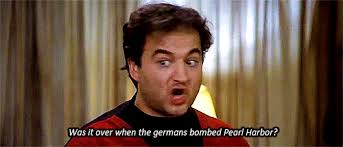
And it worked. The A’s loaded the bases with two out in the bottom of the 10th. Khris Davis looped a soft fly that the shortstop and two outfielders came close to, but not close enough. The tying and winning runs scored and the Oakland players stormed the field. Just like in the Belushi video. Not only that, the A’s kept winning over the weekend to sweep four games from the Yankees. Low payroll sometimes beats high payroll.
Tickets: I was glad the teams provided real tickets rather than sheets of paper (I know, grumpy old man).
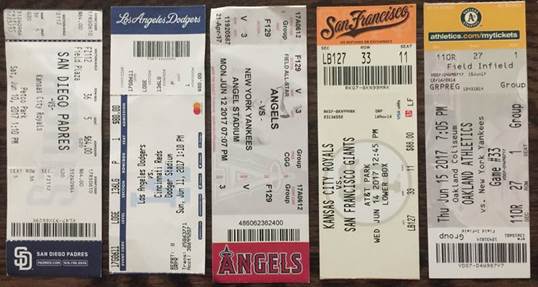
Jim Bunning, Bill Wakefield and their Perfect Game: Last month, I read the obituary of Jim Bunning in the New York Times. He won more than 100 games in each league and is in the Hall of Fame. He was later a U.S. Senator from Kentucky. The obit mentioned that he pitched a perfect game for the Phillies against the Mets in 1964. That got my attention because I knew that Bill Wakefield had pitched relief in a lot of games for the Mets in 1964 (his only major league season). I went to Baseball Reference to find the box score, and sure enough, Wake pitched in the game. In the 6th inning with two out, Mets starter Tracy Stallard was knocked out by a Phillies rally. Wake came on in relief to face Johnny Briggs who lined out to the left fielder. In the Mets half of the 6th, Wake was lifted for a pinch hitter. This meant he and Bunning were both perfect that day, Wake with the one batter he faced, and Bunning with the 27 he faced.
Bill Wakefield is a Hot Stove reader, and so I shared with him my analysis of the joint perfect game. He had no objection to my interpretation. My connection with Wake is through my law partner Irv Blond who knew Wakefield as the star senior on the 1959 Pem Day high school basketball team. Irv was on the eighth-grade Pem Day team with Randy Leathers who, like Wakefield, lives in the Bay Area. Irv and Sharyn Blond were in San Francisco when Rita and I finished our stadium tour, and so Irv and I met up with Wake and Randy for Saturday brunch. In the photo: Lonnie, Irv, Wake and Randy.
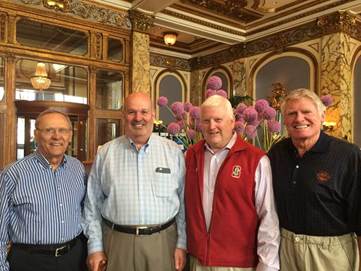
Wake was part of a golden era of baseball pitchers who came out of Kansas City’s Ban Johnson League in the late 50’s and early 60’s. In addition to Wake, these BJ players from that era also made it to the majors: Chuck Dobson, Bill Kelso, Paul Linblad, Steve Mingori, John O’Donoghue, Steve Renko and Ray Sadecki. Coming along in the 70’s were Rick Sutcliffe (from my high school Van Horn) and David Cone (a perfect game in 1999). Another BJ alumnus well known to Royals fans is second baseman and current County Executive Frank White.
Father’s Day: We returned to KC on Father’s Day, and my kids surprised me with an old-style record player to play my 45-rpm golden oldies from the 50’s. I checked to see what was on the charts 60 years ago in 1957 and selected my copy of “Come Go With Me” to put on the turntable. Still sounds great. For some additional nostalgia, I checked the roster of the 1957 Kansas City A’s. Some of those names: Joe DeMaestri, Woody Held, Hector Lopez, Vic Power, Gus Zernial, Lou Skizas, Ryne Duren, Bob Cerv, Irv Noren and Harry “Suitcase” Simpson. Now, for your listening pleasure, the Dell-Vikings, click here.
